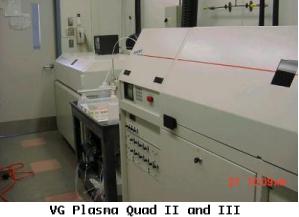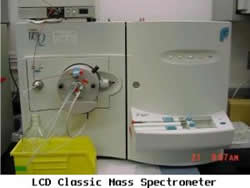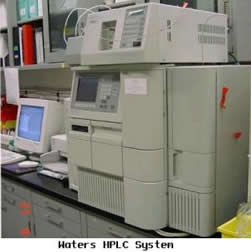Analytical Center Research: Instrumentation
The EOHSI/NJDEP Analytical Center is a state of the art facility designed to assist investigators with difficult assays of biological and environmental contaminants or their metabolites.
 This facility has both inorganic and organic analytical capabilities. The inductively coupled plasma/mass spectrometers are the centerpieces of the inorganic analytical instrumentation. They are the Fisons VG Plasma Quad II and the Fisons VG Plasma Quad III. This device has the sensitivity to detect solution concentration of metals down to pg/ml range. The ICP/MS has been used for trace metals measurement in dust water soil and biologicals for the Childhood Lead exposure Assessment and Reduction Study (CLEARS), the Treatment of Lead-exposed Children (TLC), Jersey City Chromium project, and National Human Exposure Assessment Study projects (NHEXAS).
This facility has both inorganic and organic analytical capabilities. The inductively coupled plasma/mass spectrometers are the centerpieces of the inorganic analytical instrumentation. They are the Fisons VG Plasma Quad II and the Fisons VG Plasma Quad III. This device has the sensitivity to detect solution concentration of metals down to pg/ml range. The ICP/MS has been used for trace metals measurement in dust water soil and biologicals for the Childhood Lead exposure Assessment and Reduction Study (CLEARS), the Treatment of Lead-exposed Children (TLC), Jersey City Chromium project, and National Human Exposure Assessment Study projects (NHEXAS).
Center personnel have interfaced the ICP/MS to a Dionex DX 300 ion chromatograph which has allowed for the speciation of metals at ultra-trace levels. This hyphenated technique has been applied to the separation of the carcinogenic Cr(VI) from the micro nutrient Cr(III) species. The speciation of chromium has allowed investigators to enhance their research proposals. Since this method was developed, it has been submitted for use in at least seven different research proposals including the monitoring of remediated sites in chromium contaminated areas in Hudson County. It has also been applied to the examination of chromium in health food supplements.
Mercury has also been speciated using the ICP/MS and ion chromatography technique. It can separate and quantitate the various organic and inorganic mercury species down to sub part per billion levels in solution. Solids, such as soil and lake sediments samples, have been extracted and analyzed with this method. As part of an NJ DEP funded research project for the development of methods for quantifying ultra-trace levels of the different mercury species in environmental samples mercury speciation has been used to measure the different species of mercury in many of the lakes in New Jersey.
Extraction of inorganic contaminants from almost all matrices is accomplished by closed vessel microwave digestion. The Analytical Center has a CEM 2100 D unit and CEM MARS unit where both temperature and pressure in the vessels and can be programmed for multi-step extraction procedures. The microwave digestion techniques have been used for the digestion of chromium waste contaminated soils as part of the Jersey City Chromium project. The results obtained with the nitric acid microwave extraction method have matched the hotplate HF digestion performed at Villanova University on the same soil samples. This method has also been used for the digestion of filter media used for dust wipe samples. The dust wipe sample and digest procedures have been used in the TLC study, the CLEARS study and the NHEXAS study. The mircowave has also been utilized in the extraction of pesticides from from fat. This procedure is critical in the determination of pesticides retained in the breast milk of nursing mothers.
 The Analytical Center's organic instrumentation is highlighted by the LCQ Classic Mass Spectrometer interfaced with theWaters HPLC System, and the LCQ DECA Finigan Mass Spectrometer interfaced with the Thermo Separation System.
The Analytical Center's organic instrumentation is highlighted by the LCQ Classic Mass Spectrometer interfaced with theWaters HPLC System, and the LCQ DECA Finigan Mass Spectrometer interfaced with the Thermo Separation System.
 Several methods have been developed using the HPLC/ITMS including the analysis of catechins and theoflavins. Essays for Tamoxifen (putative proginitor of hot flashes) and 3-Methoxy-4hydroxyphenyl-glycol (MHPG) have been developed using Solid Phase Extraction techniques. These were analyzed using and APCI and ESI/MS/MS. A study of the metabolism of PhIP (2-amino-1-methyl-6-phenyllimidazo[4,5,b]pyridine ) using human liver or prostate microsomes utilizes the HPLC with mass spectrometric detection using ESI positive mode with Selective Ion Monitoring and MS/MS for PhIP and
Several methods have been developed using the HPLC/ITMS including the analysis of catechins and theoflavins. Essays for Tamoxifen (putative proginitor of hot flashes) and 3-Methoxy-4hydroxyphenyl-glycol (MHPG) have been developed using Solid Phase Extraction techniques. These were analyzed using and APCI and ESI/MS/MS. A study of the metabolism of PhIP (2-amino-1-methyl-6-phenyllimidazo[4,5,b]pyridine ) using human liver or prostate microsomes utilizes the HPLC with mass spectrometric detection using ESI positive mode with Selective Ion Monitoring and MS/MS for PhIP and
N-OH-PhIP in tandem with fluorescence detection. Currently, the HPLC method to separate "-thujone (the active component of absinthe) and its metabolites and their subsequent identification by Mass Spectrometry is being developed.
 The laboratory also has two Varian Saturn GC/IT Mass Spectrometers, the 2000 and the 2200. This instrumentation is being extensively used in to determine SVOC's including PAH's, PCB's, and pesticides in enviromental samples. This research is currrentltly being funded by NJDEP and NIEHS
The laboratory also has two Varian Saturn GC/IT Mass Spectrometers, the 2000 and the 2200. This instrumentation is being extensively used in to determine SVOC's including PAH's, PCB's, and pesticides in enviromental samples. This research is currrentltly being funded by NJDEP and NIEHS
The Analytical Center possess an OLIS RSM 1000 ultra-fast scanning UV/Vis absorbance spectrometer. This device can be modified to operate in fluorescent mode and has a stop-flow system for studying reactive chemical kinetics. The stop flow system has been used to explore the reductive mechanisms of chromium VI with cellular substituents. A cellular homogenate was used as one of the reactants in the stop-flow mixing cell. End-on photomultiplier tubes and a 1 kHz scan rate have allowed for measurement of millisecond kinetics in turbid solutions. This instrument has also been used for the measurement of chromaphores in microsomal solutions. Other Center capabilities include purge and trap gas chromatography which is currently configured for analysis of volatile organic carbons. It has also been optimized for the separation of Methyl Tertiary Butyl Ether from Naphthalene. The MTBE monitoring was part of a study that looked at the embryonic mutations of freshwater fish caused by MTBE in conjunction with other fuel additives. Center personnel also have access to GC/MS, flame Atomic Absorption as well as conventional UV/Vis absorption spectroscopy.
For more information about the Analytical Center, contact: bbuckley@eohsi.rutgers.edu



